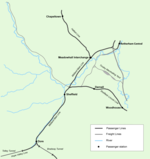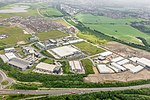Tinsley Motive Power Depot
1964 establishments in England1988 disestablishments in EnglandRail transport in SheffieldRailway depots in YorkshireTransport infrastructure completed in 1964 ... and 1 more
Use British English from February 2018

Tinsley Motive Power Depot, latterly Tinsley Traction Maintenance Depot (TMD), was a railway depot in Tinsley, South Yorkshire, near Sheffield. Access by road was from Brinsworth, near Rotherham. The depot was situated on the freight line between Treeton Junction and the A631 Shepcote Lane.
Excerpt from the Wikipedia article Tinsley Motive Power Depot (License: CC BY-SA 3.0, Authors, Images).Tinsley Motive Power Depot
Kantstraße, München Am Riesenfeld
Geographical coordinates (GPS) Address Website Nearby Places Show on map
Geographical coordinates (GPS)
| Latitude | Longitude |
|---|---|
| N 53.3956 ° | E -1.3765 ° |
Address
BMW Group Werk München
Kantstraße
80809 München, Am Riesenfeld
Bayern, Deutschland
Open on Google Maps







